Our itinerary was pretty packed, but when three different people in the space of a few days all told us, "You MUST see La Sagrada Familia!", we thought perhaps we should heed their advice. The trip wasn't just all about the gardens, anyway, it was about the gardens in the context of the country's culture. And religion and religious structures are part of a people's culture, right? Right! I'm deviating a bit from the chronological order of our itinerary but thought I'd tell you more about Antonio Gaudi and the amazing work that consumed his later life.
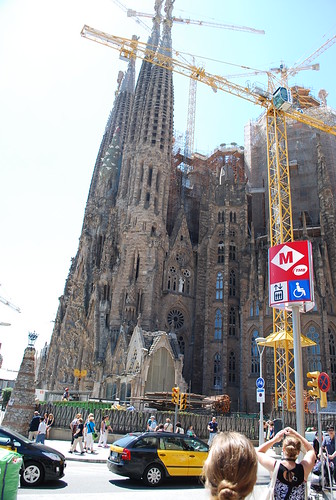
The Temple Expiatori de la Sagrada Familia (Expiatory Church of the Holy Family) is a massive Roman Catholic church designed by Gaudi, to which he devoted the last fifteen years of his life. Construction began in 1882 and is still ongoing.
Beg pardon? Still ongoing? It's been 127 years and they haven't finished it yet?
Allow me to quote Sr. Gaudí: "My client (meaning God) is in no hurry". Funding for the construction is entirely by private donations and admission fees. Gaudí himself gave all his money to the effort and went door-to-door begging for more. He lived at the church until the time of his death, at which time only the Nativity Façade had been built. Most of the original plans for the church were destroyed during the Spanish Civil War so much of what's been done since has been the inspiration of the artists and architects working on it.
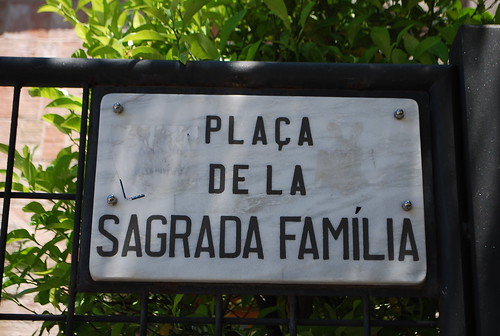
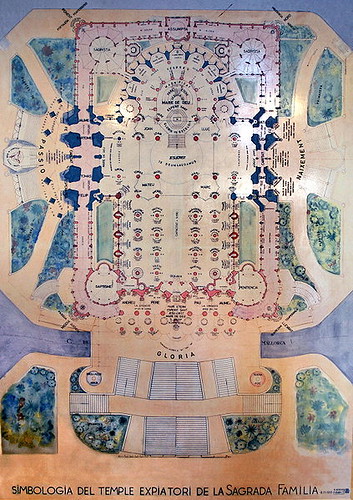
Photo from Wiki Commons
 We lunched at a sidewalk cafe right across the street from the cathedral. Impressive doesn't even begin to describe it. After queueing a short time to buy tickets, we bypassed the longer line for one of the tower elevators and went inside. I've been in several cathedrals in England - some ruins, some still active neighborhood houses of worship - and each one has taken my breath away. Even in its unfinished state this one did, too.
We lunched at a sidewalk cafe right across the street from the cathedral. Impressive doesn't even begin to describe it. After queueing a short time to buy tickets, we bypassed the longer line for one of the tower elevators and went inside. I've been in several cathedrals in England - some ruins, some still active neighborhood houses of worship - and each one has taken my breath away. Even in its unfinished state this one did, too.

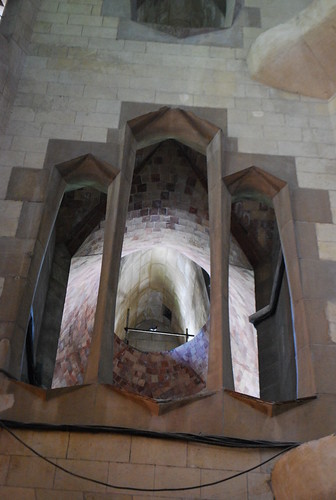
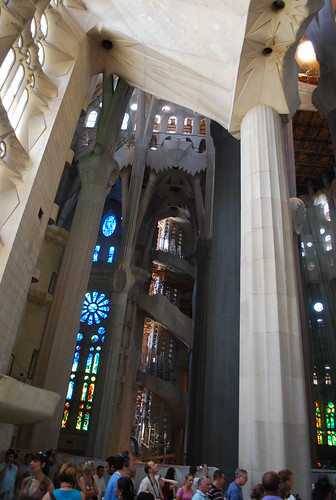
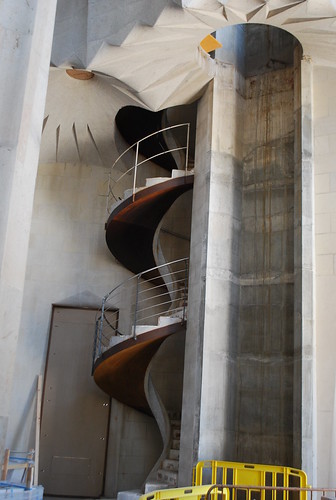
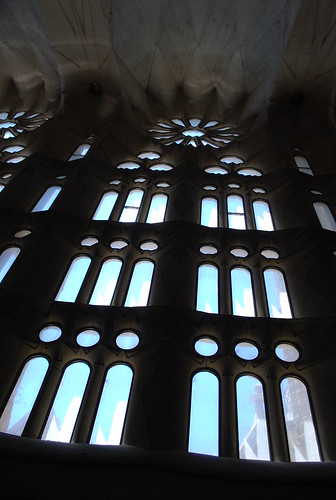 Imagine stained glass in the windows!
Imagine stained glass in the windows!
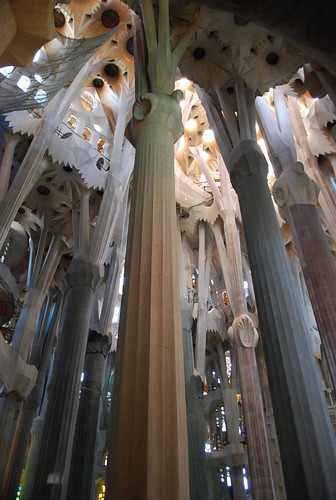
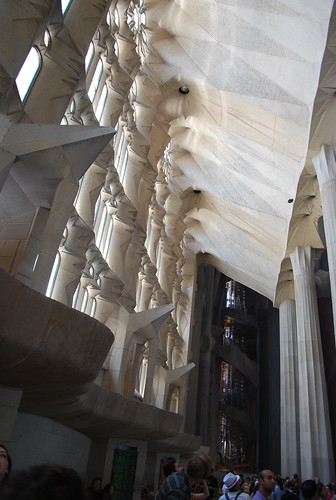 Emerging from the exit you find yourself under the Passion Façade. This depicts the passion - the pain, sacrifice, and death - of Christ. The sculptures by Josep Maria Subirachs are very stylistic. The façade faces west and receives the last rays of the setting sun, creating dramatic light and shadow effects.
Emerging from the exit you find yourself under the Passion Façade. This depicts the passion - the pain, sacrifice, and death - of Christ. The sculptures by Josep Maria Subirachs are very stylistic. The façade faces west and receives the last rays of the setting sun, creating dramatic light and shadow effects.
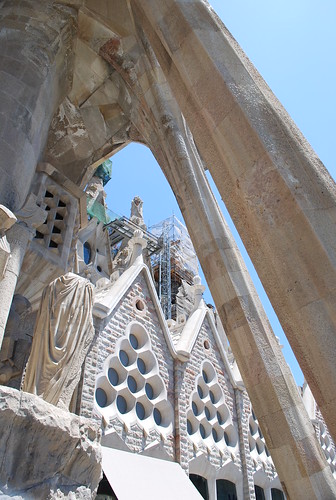

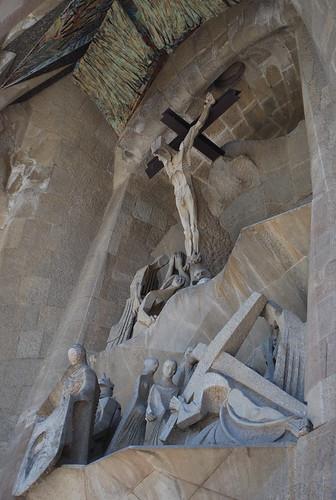 Directly opposite, on the east side of the church, is the the Nativity Façade which was the only part of the church completed in Gaudí's lifetime. Similar to the Passion Façade it depicts Jesus's birth, childhood, and early manhood. The rising sun which illuminates the façade symbolically represents new life. There are three entrances on this side, one door each for hope, charity, and faith.
Directly opposite, on the east side of the church, is the the Nativity Façade which was the only part of the church completed in Gaudí's lifetime. Similar to the Passion Façade it depicts Jesus's birth, childhood, and early manhood. The rising sun which illuminates the façade symbolically represents new life. There are three entrances on this side, one door each for hope, charity, and faith. 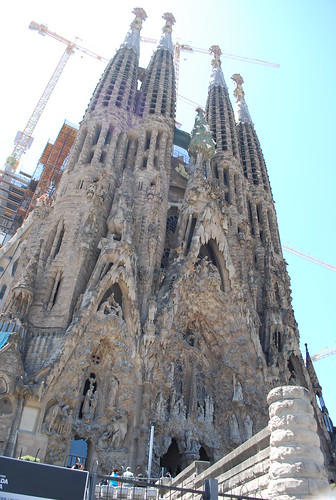
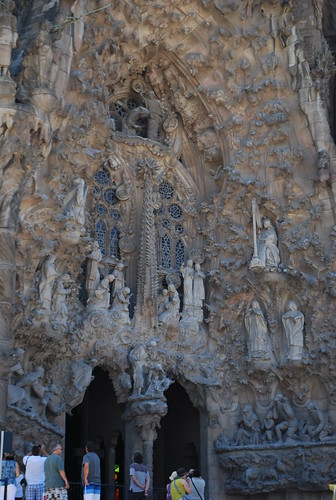
We didn't have time on this visit to take the lifts to the towers, which are supposed to be spectacular, or to visit the crypt, or really linger and take in all the astounding details. I read recently that the nave is due to be opened for public worship by October of this year, and the church is to be consecrated by the Pope when he visits Barcelona in November.
I always marveled at the dedication it took to build the medieval cathedrals I've seen - some taking decades, as Sagrada Familia has. It takes a lot of faith to put so much effort into something that you may not live to see completed. I hope to be able to return in ten years or so (with a visit or two in between) and see how much has been done. With the anticipated completion date being somewhere around 2026, I think it would be fascinating to see the progress first hand and to one day be able to enjoy a service there or hear Evensong.
Visiting this time and watching the workmen inside as they carefully smoothed a just-poured concrete floor reminded me that true craftsmanship - no matter what the discipline - requires time and patience.
Good thing God has plenty of both!




No comments:
Post a Comment